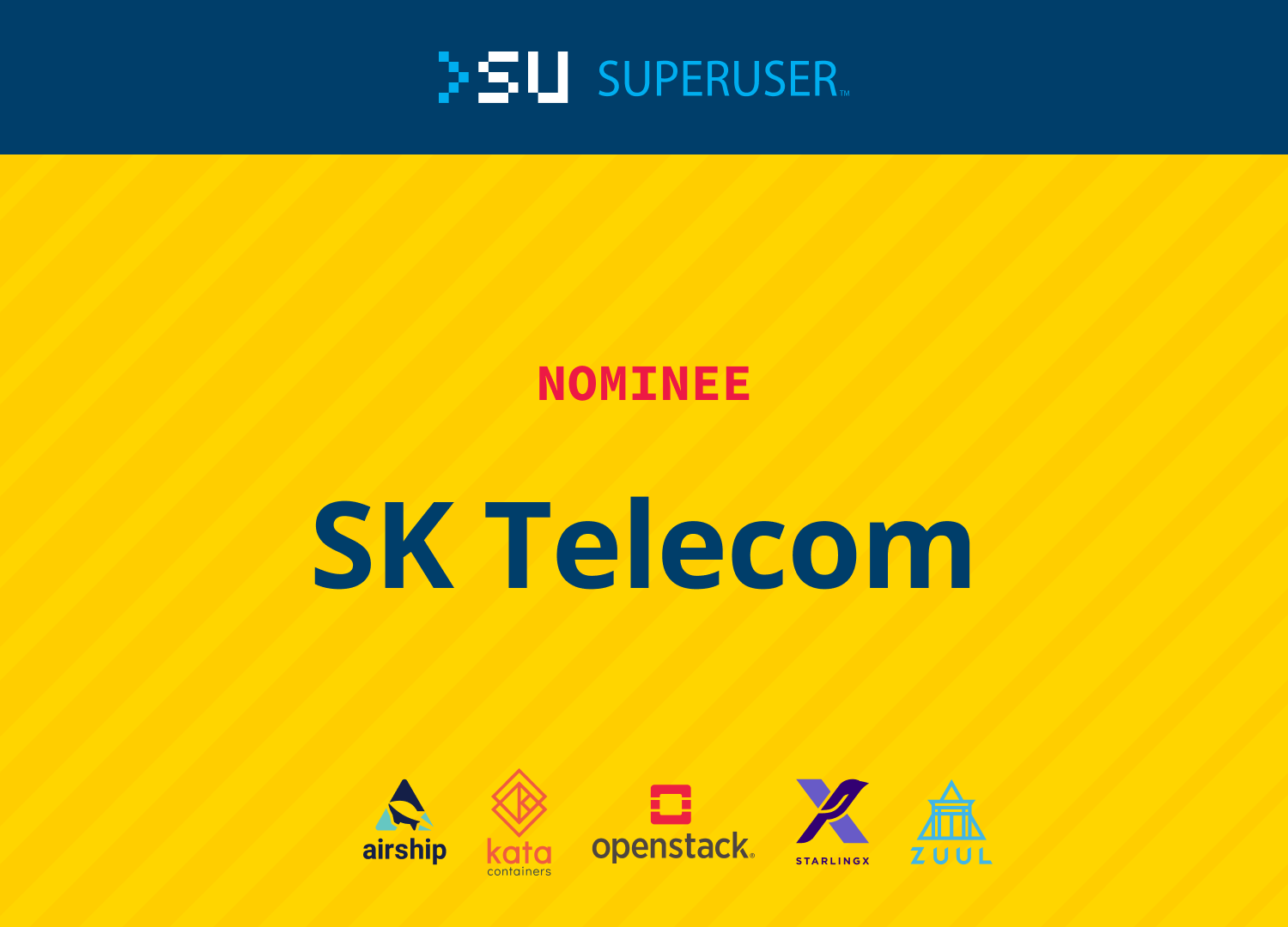It’s time for the community to help determine the winner of the 2020 Open Infrastructure Summit Superuser Awards. The Superuser Editorial Advisory Board will review the nominees and determine the finalists and overall winner after the community has had a chance to review and rate nominees.
Now, it’s your turn.
SK Telecom is one of eight nominees for the Superuser Awards. Review the nomination criteria below, check out the other nominees and rate them before the deadline September 28 at 11:59 p.m. Pacific Daylight Time.
Rate them here!
Who is the nominee?
SK Telecom 5GX Cloud Labs
The core team is Container Platform Dev Team from 5GX Cloud Lab, SK Telecom. The team has 10 members who develop cloud native infrastructure platform, called TACO (SKT All Container Orchestrator). We have been working like a skunkworks project within the company, quickly developing innovative way of managing cloud infrastructure like cloud native apps, then productize it in many important domains; Telco NFV, VDI, IPTV services, Big Data, etc. Importantly, we have worked together with AT&T and others to launch the Airship project, and been an active advocate for the project. The most of us are also core members in OpenStack, Ceph, Kubernetes community, really leading community effort here in Korea.
How has open infrastructure transformed the organization’s business?
Open Infrastructure provides standardized API sets and common software stacks so that SKT can flexibly work with partners, reducing TCO but accelerating 5G innovations. However, in-house development tightly working with open communities was not a usual case for SKT. My team has introduced and embraced it. It influenced culture and organizational changes to make both open source adoption and open source contribution accelerated (http://thubgate.sktelecom.com/). SKT also launched “private/hybrid cloud” product for B2B market in 2020 to generate new revenue streams. In addition, Joint Venture SKT created with SBG (Sinclair Broadcasting Group) in USA was an important success story for global expansion. The reputation SKT gets from open community activity played an important role.
How has the organization participated in or contributed to an open source project?
SKT is a longtime sponsor for Open Infrastructure Days Korea and support of the community. The company also encourages its employees to participate/contribute regional and global community. In 2017, my team started to work with AT&T to set up containerized OpenStack development activity. Since then, both parties collaborated to launch openstack-helm, and Airship. We presented in several Open Infrastructure Summits, PTGs, and participated in code development, reviews for openstack-helm and Airship. SKT is now opening up its software code to contribute back to community. Most of team members are long-time contributors of OpenStack (from 2010), Ceph and Kubernetes. we have a founding member of OpenStack, Ceph, and Kubernetes Korea community in the team.
What open source technologies does the organization use in its open infrastructure environment?
The important ones are OpenStack (Nova, Cinder, Glance, Keystone, Ironic, Manila, Neutron, Heat, Horizon, Kolla, openstack-helm) and its infrastructure components (mariadb, rabbitmq, memcached, etc), Airship, Ceph, and Kubernetes. In addition, Docker, Kubernetes CAPO (Cluster-API Provider OpenStack), Metal3, EFK, Prometheus and various exporters, Grafana, Lens, Ansible, Jenkins, Mariadb, PostgreSQL and more are forming the entire lifecycle of our solution. Most of them are all containerized. What’s more, leveraging all the mentioned open source technologies, we have an open source project, called HANU (https://github.com/openinfradev), composed of two main sub-projects; tacoplay and decapod.
What is the scale of your open infrastructure environment?
We run many different open infrastructure clusters based on TACO (SKT All Container Orchestrator, it is a containerized, declarative, cloud infrastructure lifecycle manager fully leveraging Kubernetes and Airship). They are not huge scale, but each serves a very important role in the company. First, some NFVs in telco network is running on taco-based OpenStack. Second, SKT’s private cloud is also based on taco-based OpenStack. Third, B2B VDI solution is based on taco-technology. Fourth, BTV (SK’s IPTV offering) services/apps are running on top of taco-based Kubernetes (five clusters). These clusters each deals with 1~6k tps request from IPTV setup boxes all around Korea (SK’s IPTV has around 5.5 million subscription). Lastly, cloud-based ATSC3.0 broadcasting/media system is on the way.
What kind of operational challenges have you overcome during your experience with open infrastructure?
Difficulties in operating OpenStack (install, partial patches, upgrade, etc) has always been big problem. As a result, company often ends up with having so many different versions of OpenStack creating operation overhead. In addition, since there are lots of loosely coupled modules in OpenStack, it has been real challenge to take care of each of them in the situation. My team’s mission was to solve these problems. Luckily, there were like-minded community members having very similar goals (Airship!). What more, by treating every infrastructure like cloud native apps, we are able to provide operators a capability to remotely deploy and manage the entire lifecycle of cloud infrastructure and add-on tools/services. This helps operating distributed, multiple clouds both for OpenStack and k8s.
How is this team innovating with open infrastructure?
– Developed a containerized OpenStack on Kubernetes solution (TACO) based on openstack-helm and Airship. We continuously extend it toward more generic “declarative cloud infrastructure lifecycle management tools”.
– Developed Gitops, Declarative Continuous Deployment Tool (DECAPOD). Airship v2 design document, discussion recording/note, prototype was a great help.
– Federated LMA covering multiple cloud infrastructure (both OpenStack and k8s), and an admin console UI, all based on open source. Especially, we actively leverage Kubernetes operator framework to control various lma tools.
– Unified management between virtual machines and containers. ONOS is a key open technology for SDN.
– Using the above to build Cloud for Telco, Media, IT, and Broadcasting System (ATSC 3.0)
Each community member can rate the nominees once by September 28 at 11:59 p.m. Pacific Daylight Time.
- Demystifying Confidential Containers with a Live Kata Containers Demo - July 13, 2023
- OpenInfra Summit Vancouver Recap: 50 things You Need to Know - June 16, 2023
- Congratulations to the 2023 Superuser Awards Winner: Bloomberg - June 13, 2023

)







